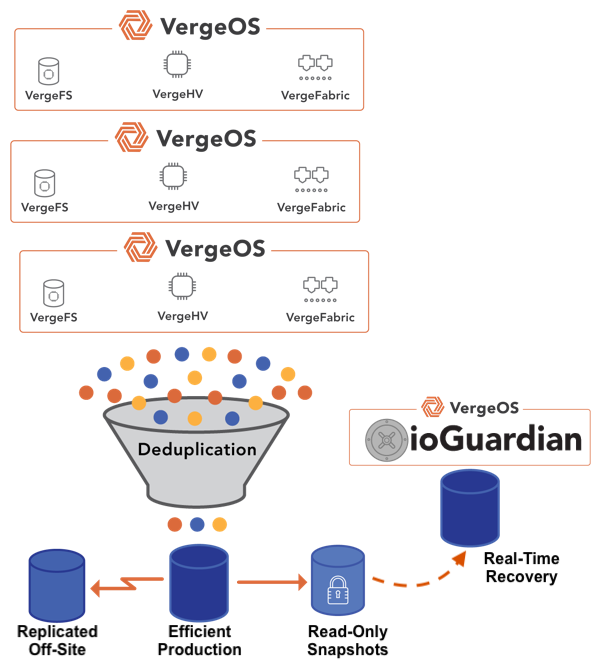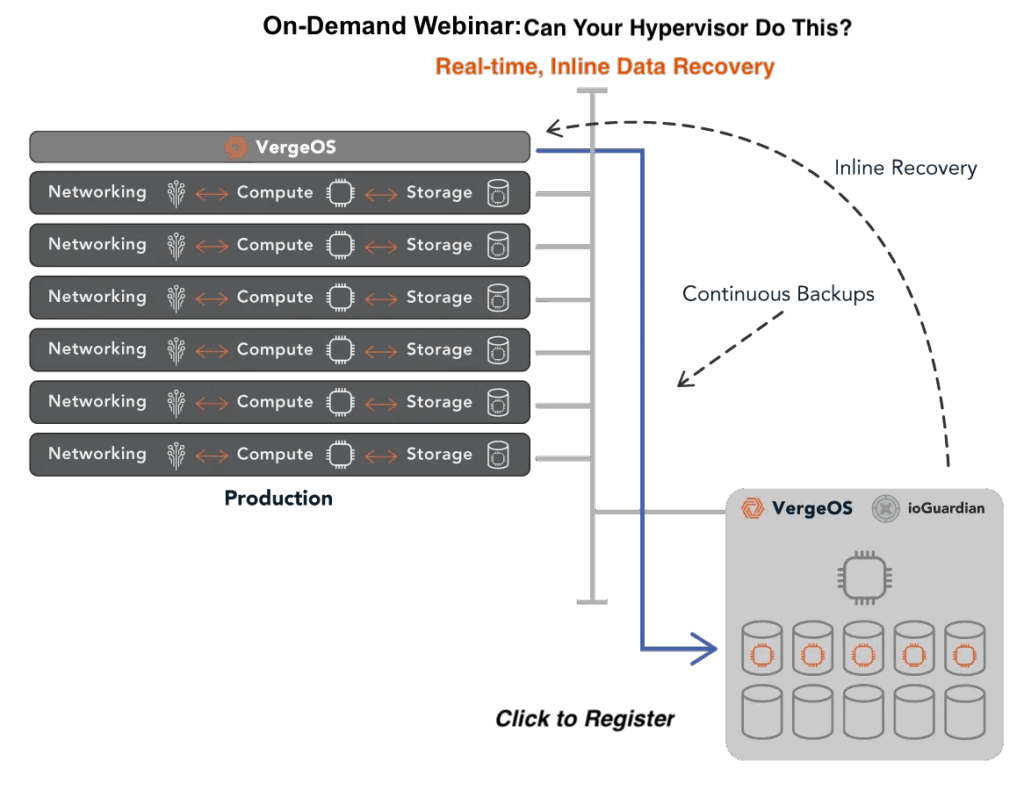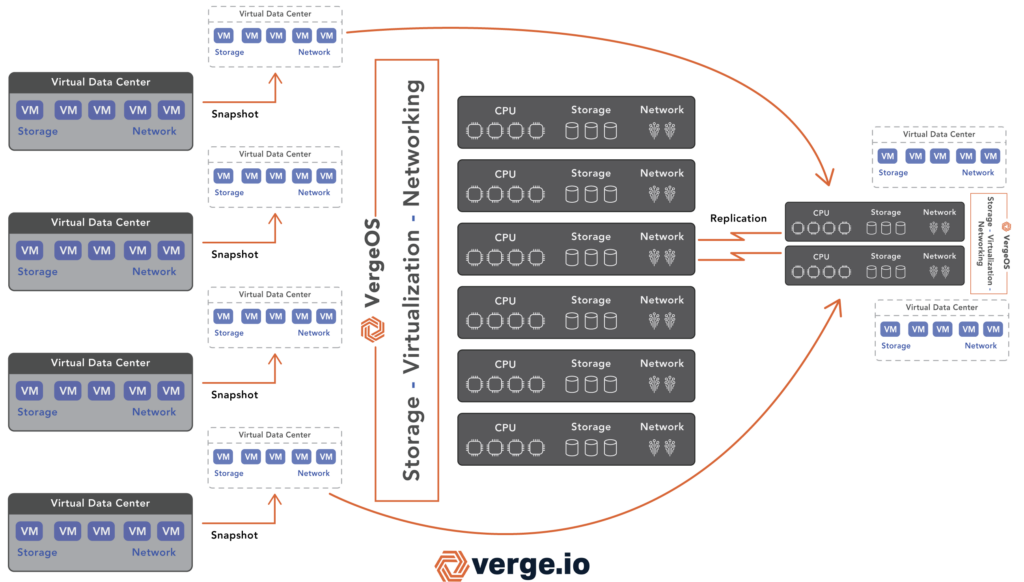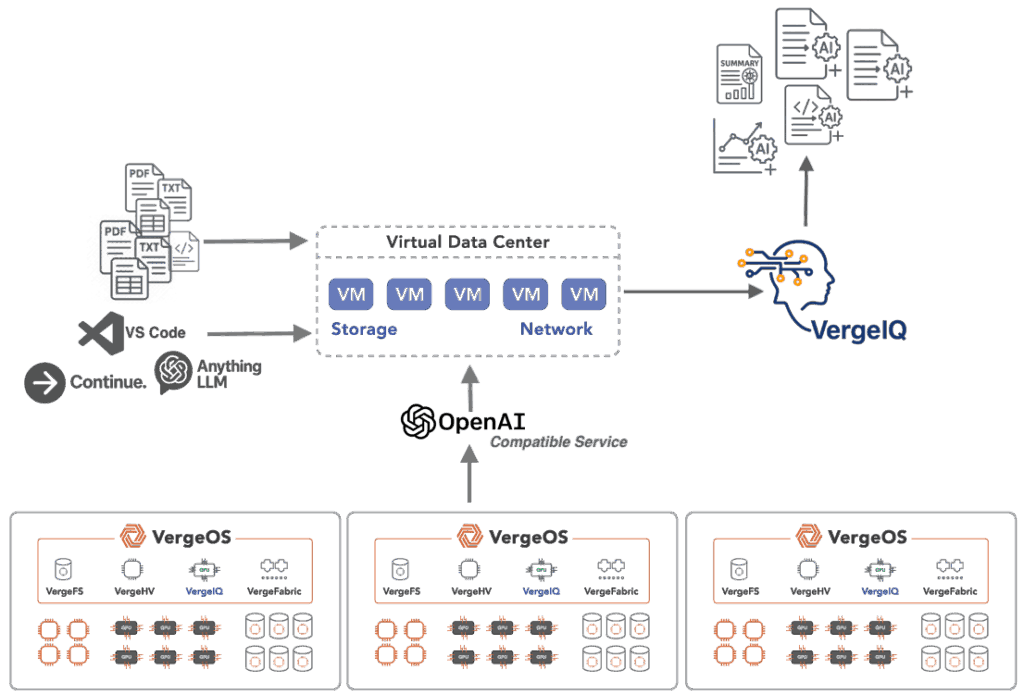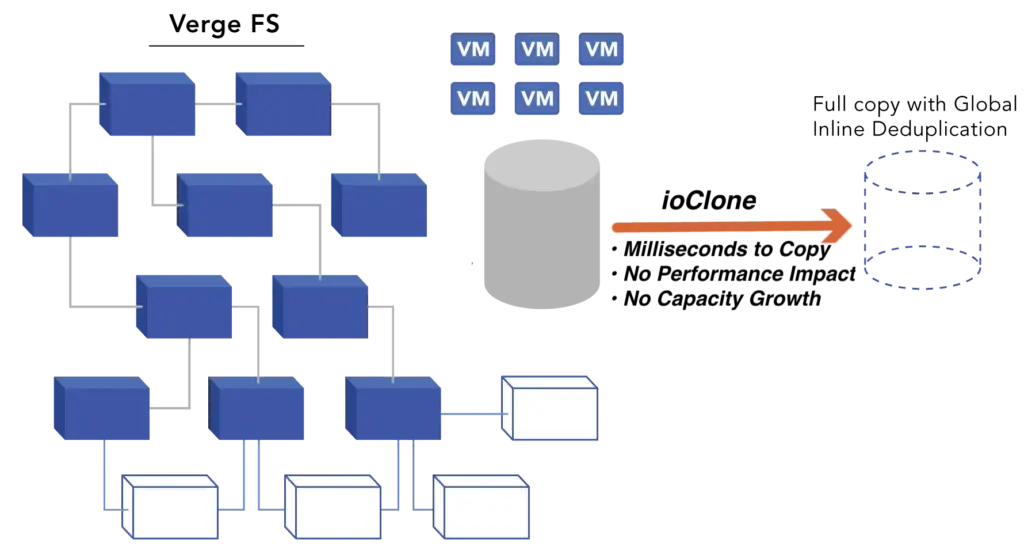The VergeIO + Solidigm AFA Replacement Kit is designed for IT teams looking for an AFA Alternative that doesn’t compromise on performance or data resiliency. It combines your existing servers with VergeOS and Solidigm’s NVMe SSDs to create a powerful, server-based storage fabric. The result is a simpler, faster, and more cost-effective solution than traditional SANs and hyperconverged stacks.
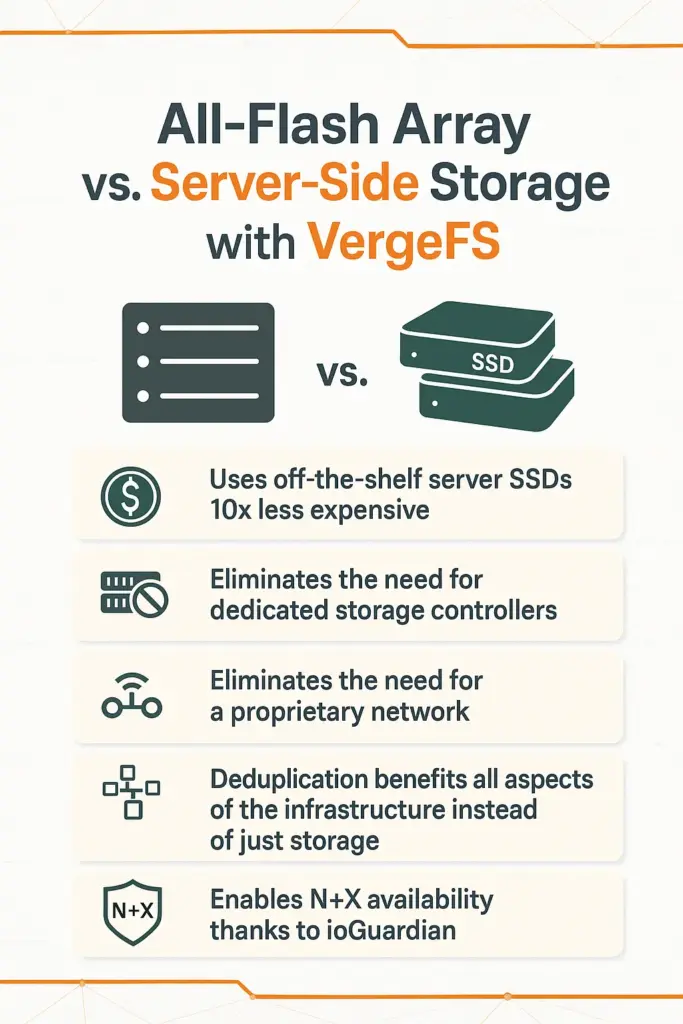
The Value of an AFA Alternative
The AFA Replacement Kit is available through VergeIO authorized resellers. It includes VergeOS and Solidigm SSDs packaged together to deliver better value than purchasing each component independently. More importantly, it’s designed to remove the guesswork from SAN replacement projects by providing the right software and hardware combination.
VergeOS—a unified platform for virtualization, storage, AI, and networking — is licensed per server. That means no variable pricing based on features, storage capacity, cores, or the number of virtual machines. The pricing model is easy to understand, easy to forecast, and built to scale.
An AFA Alternative with a VMware Exit
Many organizations considering an all-flash array refresh are also rethinking their hypervisor strategy. The Broadcom acquisition of VMware has disrupted licensing models, partner relationships, and confidence in the long-term roadmap. For IT teams planning a storage upgrade, this presents an opportunity to address two problems simultaneously.
The VergeIO + Solidigm AFA Replacement Kit offers a clear path to exit both the SAN and VMware platforms. VergeOS replaces the hypervisor, SAN, and backup layers with a single software-defined environment. There is no need to manage new licensing agreements, convert workloads to different file formats, or purchase additional software for storage functionality.
Organizations can shift away from VMware while upgrading storage at the same time. The combined result is a simplified architecture, predictable cost structure, and more control over future infrastructure decisions. Our customers consistently report a 5X to 10X cost savings.

An AFA Alternative With a Unified Architecture
VergeOS eliminates the traditional boundaries between compute, storage, and networking. Each node in the cluster can be assigned to compute, storage, or both. The architecture adapts to the environment, whether it’s a compact edge deployment or a multi-rack data center.
Data is mirrored across nodes at the disk level. There’s no need for RAID controllers, external failover scripts, or layered cluster software. VergeOS handles availability natively, because it’s built into the core of the platform.
The system supports a variety of drive types and endurance levels. Administrators can use Solidigm TLC and QLC drives in the same environment, assign tiers, and migrate VMs between them without interruption. This flexibility enables easy alignment of storage costs with performance requirements.
Deployments scale without reconfiguration. A two-node edge cluster and a 200-node private cloud run on the same software, managed from the same interface. VergeIO’s integrated Site Manager enables the single-pane-of-glass management of hundreds of sites.
An AFA Alternative with Seamless Migration
Every AFA Replacement Kit includes ioMigrate, VergeIO’s built-in tool for moving workloads from VMware environments to VergeOS. The process is straightforward and does not require specialized migration services or complex conversions.
Step 1: Install Solidigm Drives
Install Solidigm NVMe SSDs into existing servers or newly added storage nodes. VergeOS recognizes and provisions the capacity immediately. Storage-dense nodes can be added where needed, and compute nodes or GPU nodes can access that storage across the cluster.
Step 2: Migrate with ioMigrate
ioMigrate uses VMware’s Backup API to extract virtual machines from the existing SAN through VMware. The data is written directly to VergeOS, now running on Solidigm flash. There is no conversion process or downtime during the initial migration. Virtual machines run natively on VergeOS once the data is in place.
Step 3: Final Sync and Cutover
Once workloads are validated on VergeOS, ioMigrate performs a final sync using VMware’s changed block tracking (CBT). CBT ensures that only modified data is transferred. The legacy SAN can then be decommissioned or repurposed for archival or backup use.
An AFA Alternative with Broad Workload Support
VergeOS is designed to run the types of workloads commonly found in data centers. This includes:
- Windows Server and Linux
- SQL Server, PostgreSQL, MySQL, and other databases
- Domain services like Active Directory, DNS, and DHCP
- File services and print servers
- VDI platforms
- AI and machine learning workloads running on GPU-enabled nodes
While VergeOS is not designed for bare-metal workloads, many organizations find that applications previously run on physical servers perform better once virtualized within VergeOS. The platform’s tight integration and high-performance storage eliminate many of the bottlenecks that previously limited virtualized performance.
An AFA Alternative: Built-In Data Protection
VergeOS includes a complete set of tools for availability, data protection, and disaster recovery—built into the platform, not bolted on afterward.
ioClone enables space-efficient snapshots at the virtual machine or disk level. Clones are created instantly and can be used for rollback, backup, or testing. There is no penalty for frequent snapshots.
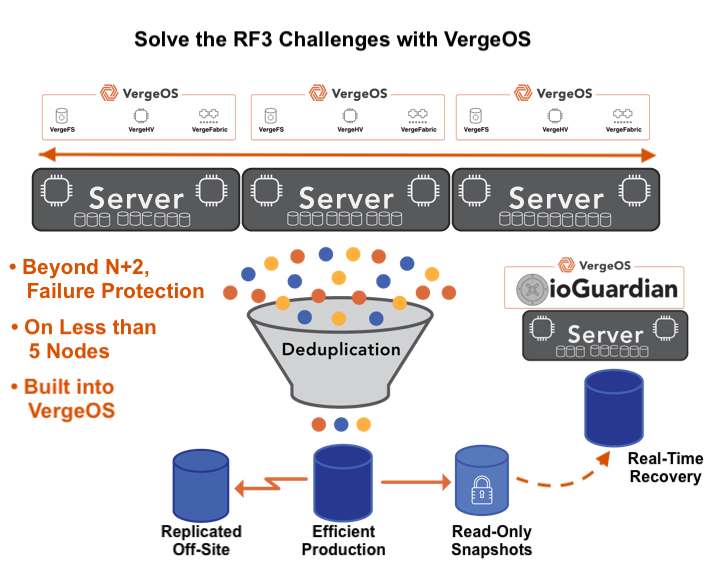
ioGuardian manages real-time data availability. When a node or drive fails, it triggers immediate failover using mirrored data from healthy nodes. If failures exceed mirror protection—such as multiple simultaneous node or drive failures—ioGuardian maintains availability using distributed object awareness. This capability exceeds what three- or four-way mirroring systems can typically recover from.
Virtual Data Centers (VDCs) enable administrators to logically and securely segment environments. VDCs contain their own compute, storage, and networking configurations, making them ideal for multi-tenant environments, departmental isolation, or testing and development.
ioReplicate enables asynchronous replication between VergeOS clusters. Replication can be scheduled, targeted by VM or VDC, and used for point-in-time recovery or to test failover without interrupting production.
Unified is Better Than HCI
Companies like Nutanix offer hyperconverged infrastructure (HCI) as an alternative to AFA, but these platforms layer storage on top of an existing hypervisor as a separate virtual machine. This “stack” adds overhead and complexity—and leaves customers managing multiple control planes.
VergeOS does not create a stack; it flattens it. The hypervisor, storage system, and data protection services are all part of a single codebase. That means better performance, easier upgrades, and fewer moving parts.
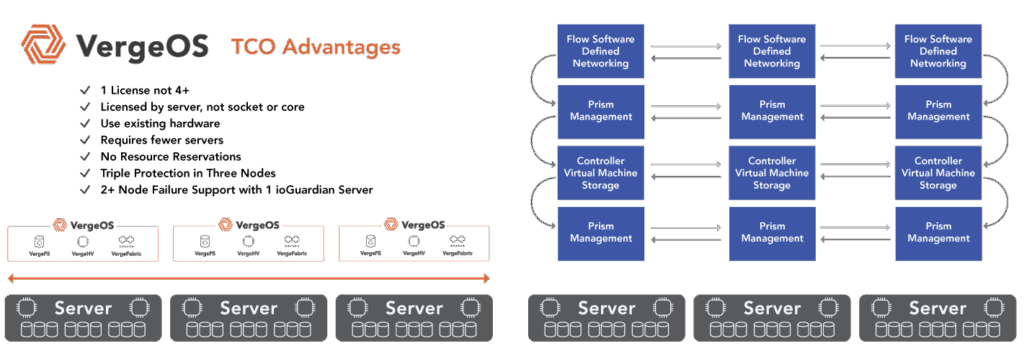
To learn more about how VergeOS compares to other HCI architectures, watch our on-demand webinar “Comparing vSAN Alternatives.”
Ideal Use Cases for the AFA Replacement Kit
The AFA Replacement Kit fits best in organizations that:
- Are replacing aging SAN infrastructure
- Want to reduce cost (by 10X) without reducing availability
- Are planning a VMware exit and need storage continuity
- Want to simplify management and reduce dependency on multiple vendors
- Prefer to extend the life of existing hardware instead of investing in new appliances
Not Another Storage Silo
This program is not a hardware launch. VergeIO is not entering the storage array market. The AFA Replacement Kit is designed to help customers utilize existing or off-the-shelf servers, eliminating the need for an external SAN without requiring the replacement of another standalone product.
There are no controllers, no shared chassis, and no fixed hardware configurations. Customers build the environment they need, using the servers they own.
Summary: A Purpose-Built Replacement
The VergeIO + Solidigm AFA Replacement Kit is a comprehensive AFA replacement that uses your existing servers to deliver enhanced control, improved performance, and a VMware exit, all while offering lower costs, with fewer hardware components and fewer moving parts.
It works because it’s built from the ground up to do what the modern data center requires—and nothing it doesn’t.


